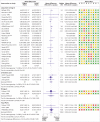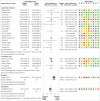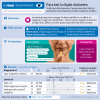Omega-3, omega-6, and total dietary polyunsaturated fat for prevention and treatment of type 2 diabetes mellitus: systematic review and meta-analysis of randomised controlled trials
- PMID: 31434641
- PMCID: PMC6699594
- DOI: 10.1136/bmj.l4697
Omega-3, omega-6, and total dietary polyunsaturated fat for prevention and treatment of type 2 diabetes mellitus: systematic review and meta-analysis of randomised controlled trials
Abstract
Objective: To assess effects of increasing omega-3, omega-6, and total polyunsaturated fatty acids (PUFA) on diabetes diagnosis and glucose metabolism.
Design: Systematic review and meta-analyses.
Data sources: Medline, Embase, Cochrane CENTRAL, WHO International Clinical Trials Registry Platform, Clinicaltrials.gov, and trials in relevant systematic reviews.
Eligibility criteria: Randomised controlled trials of at least 24 weeks' duration assessing effects of increasing α-linolenic acid, long chain omega-3, omega-6, or total PUFA, which collected data on diabetes diagnoses, fasting glucose or insulin, glycated haemoglobin (HbA1c), and/or homoeostatic model assessment for insulin resistance (HOMA-IR).
Data synthesis: Statistical analysis included random effects meta-analyses using relative risk and mean difference, and sensitivity analyses. Funnel plots were examined and subgrouping assessed effects of intervention type, replacement, baseline risk of diabetes and use of antidiabetes drugs, trial duration, and dose. Risk of bias was assessed with the Cochrane tool and quality of evidence with GRADE.
Results: 83 randomised controlled trials (mainly assessing effects of supplementary long chain omega-3) were included; 10 were at low summary risk of bias. Long chain omega-3 had little or no effect on likelihood of diagnosis of diabetes (relative risk 1.00, 95% confidence interval 0.85 to 1.17; 58 643 participants, 3.7% developed diabetes) or measures of glucose metabolism (HbA1c mean difference -0.02%, 95% confidence interval -0.07% to 0.04%; plasma glucose 0.04, 0.02 to 0.07, mmol/L; fasting insulin 1.02, -4.34 to 6.37, pmol/L; HOMA-IR 0.06, -0.21 to 0.33). A suggestion of negative outcomes was observed when dose of supplemental long chain omega-3 was above 4.4 g/d. Effects of α-linolenic acid, omega-6, and total PUFA on diagnosis of diabetes were unclear (as the evidence was of very low quality), but little or no effect on measures of glucose metabolism was seen, except that increasing α-linolenic acid may increase fasting insulin (by about 7%). No evidence was found that the omega-3/omega-6 ratio is important for diabetes or glucose metabolism.
Conclusions: This is the most extensive systematic review of trials to date to assess effects of polyunsaturated fats on newly diagnosed diabetes and glucose metabolism, including previously unpublished data following contact with authors. Evidence suggests that increasing omega-3, omega-6, or total PUFA has little or no effect on prevention and treatment of type 2 diabetes mellitus.
Systematic review registration: PROSPERO CRD42017064110.
Published by the BMJ Publishing Group Limited. For permission to use (where not already granted under a licence) please go to http://group.bmj.com/group/rights-licensing/permissions.
Conflict of interest statement
Competing interests: All authors have completed the ICMJE uniform disclosure form at www.icmje.org/coi_disclosure.pdf (available on request from the corresponding author) and declare: all authors had financial support via the University of East Anglia from the World Health Organization for the submitted work, and LH and AA were funded to attend WHO meetings and present review results; no financial relationships with any organisations that might have an interest in the submitted work in the previous three years; no other relationships or activities that could appear to have influenced the submitted work.
Figures






Comment in
-
Whether one burns fat, and not the type of fat one eats, is the important thing in type 2 diabetes.BMJ. 2019 Sep 27;366:l5700. doi: 10.1136/bmj.l5700. BMJ. 2019. PMID: 31562120 No abstract available.
References
-
- World Health Organization Global Report on Diabetes. WHO, 2016.
-
- GBD 2015 Disease and Injury Incidence and Prevalence Collaborators Global, regional, and national incidence, prevalence, and years lived with disability for 310 diseases and injuries, 1990-2015: a systematic analysis for the Global Burden of Disease Study 2015. Lancet 2016;388:1545-602. 10.1016/S0140-6736(16)31678-6 - DOI - PMC - PubMed
Publication types
MeSH terms
Substances
LinkOut - more resources
Full Text Sources
Medical
Miscellaneous
